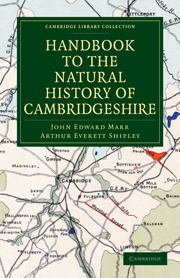Book contents
- Frontmatter
- PREFACE
- Contents
- ADDENDA AND CORRIGENDA
- PHYSIOGRAPHY
- GEOLOGY
- VERTEBRATE PALÆONTOLOGY
- ZOOLOGY
- Mammals
- Birds
- Reptiles and Amphibians
- Fishes
- Mollusca
- Insects: Introduction
- Insects: Orthoptera
- Insects: Neuroptera
- Insects: Hemiptera
- Insects: Coleoptera
- Insects: Lepidoptera
- Insects: Diptera
- Insects: Hymenoptera
- Myriapoda
- Arachnida
- Crustacea
- FLORA
- PREHISTORIC ARCHÆOLOGY
- Appendix to the Article on the Mollusca
- INDEX
- Plate section
Insects: Lepidoptera
Published online by Cambridge University Press: 10 November 2010
- Frontmatter
- PREFACE
- Contents
- ADDENDA AND CORRIGENDA
- PHYSIOGRAPHY
- GEOLOGY
- VERTEBRATE PALÆONTOLOGY
- ZOOLOGY
- Mammals
- Birds
- Reptiles and Amphibians
- Fishes
- Mollusca
- Insects: Introduction
- Insects: Orthoptera
- Insects: Neuroptera
- Insects: Hemiptera
- Insects: Coleoptera
- Insects: Lepidoptera
- Insects: Diptera
- Insects: Hymenoptera
- Myriapoda
- Arachnida
- Crustacea
- FLORA
- PREHISTORIC ARCHÆOLOGY
- Appendix to the Article on the Mollusca
- INDEX
- Plate section
Summary
RHOPALOCERA
Although Cambridgeshire cannot be considered a good butterfly county, yet with records made in the earlier part of last century, most of which are quite reliable, a list might be formed comprising some sixty species, which is within half-a-dozen of the complete British list; at the present time however it would not be easy to find more than thirty-five species.
Most important of these, the Swallow-tailed butterfly, Papilio machaon, L., still exists in considerable numbers in Wicken Fen, but it is no longer found in the surrounding fens and north of Ely, where it was plentiful fifty or sixty years ago. Aporia crataegi, L., probably, and Leucophasia sinapsis, L. certainly occurred in the woods near Gamlingay in the time of Jenyns, the latter not uncommonly; it was taken there by Prof. Babington as late as 1835. Pieris daplidice, L., has been frequently taken, but not recently, on the chalk between Cambridge and Newmarket. In years notable for a visitation of “Clouded yellows,” the two species of Colias, C. edusa, Fb., and C. hyale, L., have been taken in most parts of the county, but nowhere in such abundance as on the chalk in the south-east. There are records for all the “Fritillaries,” of which the two small species of Argynnis, A. selene, Schiff., and A. euphrosyne, L., may still occur at Gamlingay; A. aglia, L. was common in Bottisham and the adjacent fens, up to thirty years ago, and Melitaea aurinia, Rott. also occurred in various parts of the fens, but has not been recently recorded.
- Type
- Chapter
- Information
- Handbook to the Natural History of Cambridgeshire , pp. 161 - 172Publisher: Cambridge University PressPrint publication year: 2010First published in: 1904

